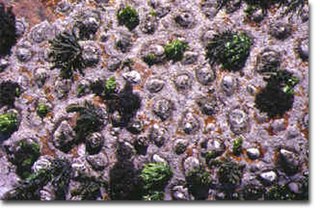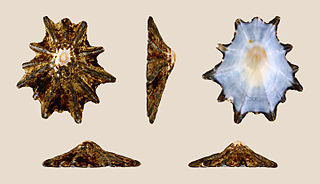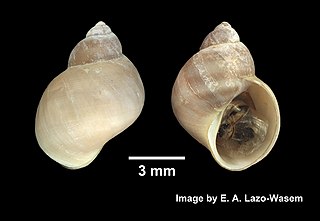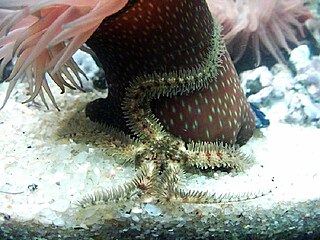
The Patellogastropoda, common name true limpets and historically called the Docoglossa, are members of a major phylogenetic group of marine gastropods, treated by experts either as a clade or as a taxonomic order.

Patella ferruginea, commonly known as the ferruginous limpet is a species of true limpet, a marine gastropod mollusk in the family Patellidae. It is a large limpet, endemic to the western Mediterranean Sea, and although common in the past, it is now rare and restricted to only a few locations.

Scutellastra cochlear is a species of sea snail, a marine gastropod mollusc in the family Patellidae, one of the families of true limpets. It is commonly known as the snail patella, the pear limpet or the spoon limpet and is native to South Africa. It often grows in association with the crustose coralline alga Spongites yendoi and a filamentous red alga which it cultivates in a garden. It was first described by the malacologist Ignaz von Born in 1778 as Patella cochlear.

Scutellastra longicosta, the long-spined limpet or the duck's foot limpet, is a species of true limpet, a marine gastropod mollusk in the family Patellidae, one of the families of true limpets. It is native to the coasts of South Africa where it is found on the foreshore. It cultivates a species of crustose brown algae in a "garden".
Gibbula verdensis is a species of sea snail, a marine gastropod mollusk in the family Trochidae, the top snails.

Lacuna vincta, commonly known as northern lacuna, wide lacuna, northern chink shell, or banded chink shell, is a species of sea snail, a marine gastropod mollusk in the family Littorinidae, the winkles or periwinkles. It is found intertidally and in shallow waters in both the northern Atlantic Ocean and the northern Pacific Ocean. It is a herbivore, feeding on seaweed and diatoms with its toothed radula.
Dendropoma corallinaceus, common name the colonial worm shell, is a species of sea snail, a marine gastropod mollusk in the family Vermetidae, the worm snails or worm shells.
Dendropoma maximum is a species of sea snail, a marine gastropod mollusk in the family Vermetidae, the worm snails or worm shells.

Onustus longleyi is a species of large sea snail, a marine gastropod mollusk in the family Xenophoridae, the carrier shells.

Novocrania anomala is a species of brachiopod found offshore in the eastern Atlantic Ocean.

Sabellastarte spectabilis is a species of benthic marine polychaete worm in the Sabellidae family. It is commonly known as the feather duster worm, feather duster or fan worm. It is native to tropical waters of the Indo-Pacific but has spread to other parts of the world. It is popular in aquariums because of its distinctive appearance and its ability to remove organic particles and improve water quality.

Ophiothrix fragilis is a species of brittle star in the order Ophiurida. It is found around the coasts of western Europe and is known in Britain as the common brittle star. It is also found along the coast of South Africa where it is known as the hairy brittle star.

Serpula vermicularis, known by common names including the calcareous tubeworm, fan worm, plume worm or red tube worm, is a species of segmented marine polychaete worm in the family Serpulidae. It is the type species of the genus Serpula and was first described by Carl Linnaeus in his 1767 12th edition of Systema Naturae. It lives in a tube into which it can retract.

Pollicipes polymerus, commonly known as the gooseneck barnacle or leaf barnacle, is a species of stalked barnacle. It is found, often in great numbers, on rocky shores on the Pacific coasts of North America.

Sabella spallanzanii is a species of marine polychaete worms in the family Sabellidae. Common names include the Mediterranean fanworm, the feather duster worm, the European fan worm and the pencil worm. It is native to shallow waters in the northeastern Atlantic Ocean and the Mediterranean Sea. It has spread to various other parts of the world and is included on the Global Invasive Species Database.

Spongites yendoi is a species of crustose red seaweed with a hard, calcareous skeleton in the family Corallinaceae. It is found on the lower shore as part of a diverse community in the southeastern Atlantic Ocean and the Indo-Pacific Ocean.

Phoronis australis is a species of marine horseshoe worm in the phylum Phoronida. It is found in shallow warm-temperate and tropical waters in the eastern Atlantic Ocean and the Indo-Pacific region and was first detected in the Mediterranean Sea in the late twentieth century. These worms live in association with tube-dwelling anemones, particularly those in the genus Cerianthus.
Salmacina dysteri is a species of tube-forming annelid worm in the family Serpulidae. It is found on submerged rocks, reefs, piles and boats in many shallow and deeper water environments around the world.

Eupentacta quinquesemita is a species of sea cucumber, a marine invertebrate with an elongated body, a leathery skin and tentacles surrounding the mouth. It is commonly known as the stiff-footed sea cucumber or white sea cucumber, and occurs on rocky coasts in the northeastern Pacific Ocean.
Hydroides ezoensis is a species of tube-forming annelid worm in the family Serpulidae. It is native to the temperate northern Pacific and the central Indo-Pacific and is found in the intertidal zone and on submerged rocks, shells, pilings, jetties and boats.













